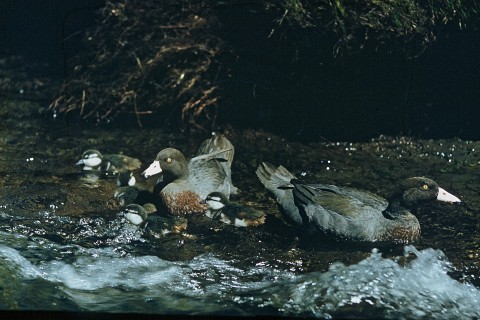The foreigner and the natives
Blogger: Brazilian Unitec journalism student and Forest & Bird intern, Diego Mandarino.
I had barely just touched down in New Zealand and I was given the opportunity to meet and greet 20 of its most endangered species.
In fact, as I wandered around Auckland Zoo’s new enclosure – Te Wao Nui – I was unsure whether I was taking part in what is described as ‘extinction’ tourism, or whether I was peering into a more hopeful future.
The $16 million dollar area will be home to about 60 animal species, some of them rare and critically endangered like the Campbell Island teal.
The area is comprised of six habitat areas – coast, islands, wetlands, day forest, night (caves and forest) and high country – and contains a handful of threatened citizens in each.
As I wandered throughout the enclosure, I learnt a lot about conservation in New Zealand and the concept of island sanctuaries to protect your endangered wildlife.
Illegal logging rather than pests is our major problem in Brazil, having said that, we have over 300 invasive species and we don’t utilise our islands to preserve these threatened species. It was inspiring to learn about the innovation and drive of those people who first populated these species-saving islands.
Surprisingly for me, the director of the Zoo John Wilcken informed me that New Zealanders know very little about their own native species, and this is one of the goals of the Zoo – to tell the story of these little-seen creatures.
As you take a walk through the 3ha precinct, you’re taken into areas that are covered by huge steel mesh domes – through tunnels, alongside streams and past tanks filled with seals.
One of the most interesting enclosures was a tunnel complete with LED stars, that contained short tailed bats, weta and endangered Brown kiwi – a bird that scuttled in front of me and probed the ground barely two inches from my nose.
The nocturnal precinct will allow researchers to learn more about the habits of species such as the short-tailed bat and weta.
Indeed, the zoo is not only a site of wildlife interest; it also plays an important role in conservation.
Breeding programmes are being carried out for a number of species including the Brown teal, North Island kaka, blue duck, kiwi and tuatara.
Brown teal eggs, for example, are hatched at the zoo and the offspring is taken to a pest controlled park called Peacock Springs in Christchurch.
Once they have matured the ducks are then released to different locations. The Brown teal used to be incredibly widespread, but now they are only found on Great Barrier Island.
Of all the threatened species, I was most honoured to meet your living dinosaur – the tuatara . I never imagined I’d meet a reptile from the time when dinosaurs walked the Earth. It was shocking to learn that it too is threatened, but then I was heartened to discover that the zoo provides a safe ‘dinosaur creche’ and incubation service.
I was very impressed with the conservation efforts carried out by New Zealanders – the future is definitely hopeful. Unfortunately, many people still do not care about conservation. It is the same thing back home. The ones who do care though are making a big difference.
Here is a list of the animals that are currently on display at the Zoo, with the respective classification in the IUCN red list. The zoo hopes to introduce more species over the next few years.
Banded kokopu – vulnerable
Banded rail – ?
Bellbird (korimako) – least concern
Black mudfish – data deficient
Brown kiwi – endangered
Cave weta – ?
Chevron skink – vulnerable
Climbing galaxias (koaro) – no data
Common bully (pako) – no data
Cook Strait tuatara (from the unique reptile group, Sphenodontia) – lower risk
Cran’s bully – no data
Falla’s skink – vulnerable
Flax snail (pupu harakeke) – vulnerable
Forest gecko – no data
Giant kokopu – vulnerable
Grey teal (tete) – least concern
Inanga – vulnerable
Jewelled gecko – near threatened
Kea – vulnerable (pop.trend: decreasing)
Koura (freshwater crayfish) – no data
Kukupa (also known as kereru/New Zealand wood pigeon) – near threatened (pop.trend: decreasing)
Little blue penguin (korora) – least concern
Longfin eel (know locally as orea) – no data
Morepork (ruru) – least concern
New Zealand dotterel – endangered (pop. trend: decreasing)
New Zealand fur seal (kekeno) – least concern
New Zealand scaup (papango) – least concern
New Zealand shoveler (kuruwhengi) – least concern
North Island kaka – endangered (decreasing)
North Island weka – vulnerable (decreasing)
Northland green gecko – no data
Otago skink – endangered (decreasing)
Paradise shelduck (putangitangi) – least concern
Pateke (brown teal) – endangered (increasing)
Red-crowned kakariki – vulnerable
Red-finned bully (toitoi) – ?
Rough gecko – lower risk/least concern
Short-tailed bat (pekapeka) – (critically endangered/vulnerable?)
Silvereye (tahou) – least concern
Spotted shag (parekareka) – least concern
Sub-Antarctic fur seal – least concern
Torrent fish (papamako) – no data
Tui – least concern
Whio (blue duck) – endangered (decreasing)
White-faced heron (matuku) – least concern
Yellow-crowned kakariki – near threatened (decreasing)

